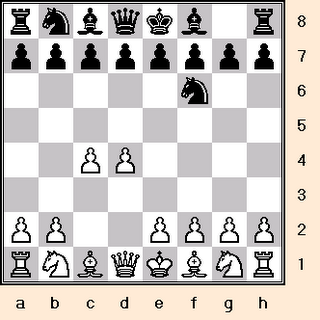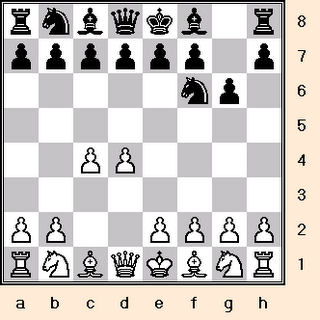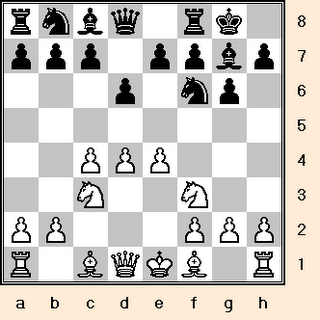Chess: Understanding the Classical King's Indian Part I
1 d4 Nf6 2 c4 g6 3 Nc3 Bg7 4 e4 d6 5 Nf3 0-0
6 Be2 e5 7 0-0 Nc6 8 d5 Ne7 Line

What's the game plan for White?

* The pawn structure obligates White to
conduct a queenside attack.
* White intends to play b4 and c5,
gaining space and assailing the vulnerable
d6 square. The attack on d6 is augmented
by Nd2-c4 and Nb5 or Ba3 and b5.
* After opening the c-file by c5xd6,
White threatens a queenside penetration of
Black's position by Rc1-Qc2 and Nb5, and,
sometimes, the a7 pawn comes under fire by
Be3 and Nb5.
What's the game plan for Black?

* The pawn structure dictates Black to
execute a kingside attack.
* Black's counterplay lies in moving
the knight on f6 to enable f5, after which
the knight returns to f6 and forces White
to defend e4 with f3.
* Black then attacks White's king
beginning with f4 followed by advancing
the g- and h-pawns and trying to force the
g4 breakthrough.
* In many lines, it is also worth
Black's while to hold White up on the
queenside by playing c6 and maybe b5.
Also available:
Chess: Understanding the Classical King's Indian
Part II
http://chesscoach1950.blogspot.com/2006/05/chess-understanding-classical-kings.html
Chess: Understanding the King's Indian Defense
(Four Pawns Attack)
http://chesscoach1950.blogspot.com/2006/07/chess-understanding-kings-indian.html
Chess: Understanding the King's Indian Defense
http://chesscoach1950.blogspot.com/2006/07/chess-understanding-kings-_115334967809416889.html
Chess: Understanding the King's Indian Defense
(g3 Systems)
http://chesscoach1950.blogspot.com/2006/08/chess-understanding-kings-indian.html
1 d4

Opening up a diagonal for the c1 bishop and attacking
the e5 and c5 squares.
1 ... Nf6

Developing the knight and also controlling
the squares d5 and e4.
2 c4

White challenges Black's claim to d5.
The d1-a4 diagonal also opens up for
the Queen.
2 ... g6

In preparation for placing the f8 bishop on g7,
where it will scope out the a1-h8 diagonal.
3 Nc3

Mobilization towards the center. Now the e4 square
is no longer under Black's sole control.
3 Nf3
3 g3
3 f3
3 d5
3 Bg5
3 Nd2
3 e3
3 b3
3 e4
3 Bf4
3 ... Bg7

3 ... d5
3 ... d6
3 ... c5
3 ... c6
4 e4

White opens up a diagonal for the Queen and f1 bishop.
He also attacks the d5 and f5 squares.
4 Nf3
4 g3
4 Bg5
4 Bf4
4 d5
4 e3
4 f4
4 f3
4 ... d6

Preparing for ... e5 . Additionally, a diagonal is
opened up for the c8 bishop.
4 ... O-O
4 ... c5
5 Nf3

The central e5 square comes into the knight's view
and the d4 pawn gets another defender.
5 Be2
5 f3
5 h3
5 Bd3
5 Nge2
5 Bg5
5 g3
5 Be3
5 Bf4
5 f4 O-O 6 e5 Nfd7 7 Nf3 c5.
5 ... 0-0

Assigning the King to a safe position and activating
the h8 rook.
5 ... c5
5 ... Bg4
5 ... Nbd7
5 ... e5
5 ... c6
5 ... Nc6
6 Be2

White prepares to castle.
6 h3
6 Be3
6 Bg5
6 g3
6 Bd3
6 Ne2
6 Ng5
6 ... e5

Staking a claim in the center. Also, by attacking d4,
the e5 pawn augments the latent pressure exerted on
that square by the g7 bishop. Note how the bishop
comes to life along the a1-h8 diagonal, once the
f6 knight is developed elsewhere.
6 ... Na6
6 ... Bg4
6 ... Nbd7
6 ... c5
6 ... c6
6 ... Nc6
6 ... a5
6 ... a6
6 ... Qe8
7 0-0

Completing kingside development.
7 d5
7 Bg5
7 h3
7 Qc2
7 dxe5 dxe5 8 Qxd8 Rxd8 9 Bg5 Re8
10 Nd5 Nxd5 11 cxd5 c6 12 Bc4 cxd5 13 Bxd5.
7 Be3 Ng4 8 Bg5 f6 9 Bh4 Nc6
10 d5 Ne7 11 Nd2 Nh6 12 f3 c6 13 dxc6 bxc6
14 b4 Be6 15 Nb3 d5 16 Nc5 Bf7 17 cxd5 cxd5
18 exd5 Nhf5 19 Bf2 Nxd5 20 Nxd5 Bxd5.
7 ... Nc6

The knight comes into the game and further
pressures the d4 pawn.
7 ... Nbd7
7 ... Na6
7 ... exd4
7 ... c6
7 ... Qe8
7 ... Nh5
7 ... a5
7 ... Qe7
7 ... Bg4
7 ... c5
8 d5

Evading the heat and attacking c6.
8 Be3
8 dxe5
8 b4
8 ... Ne7

8 ... Nb8 9 Bg5 a5 10 Nd2 Na6 11 a3 Bd7 12 Qc2 Qe8
13 Nb5 h5 14 Rae1 Nh7 15 Be3 h4 16 Kh1 b6.
By ChessCoach@care2.com
6 Be2 e5 7 0-0 Nc6 8 d5 Ne7 Line

What's the game plan for White?

* The pawn structure obligates White to
conduct a queenside attack.
* White intends to play b4 and c5,
gaining space and assailing the vulnerable
d6 square. The attack on d6 is augmented
by Nd2-c4 and Nb5 or Ba3 and b5.
* After opening the c-file by c5xd6,
White threatens a queenside penetration of
Black's position by Rc1-Qc2 and Nb5, and,
sometimes, the a7 pawn comes under fire by
Be3 and Nb5.
What's the game plan for Black?

* The pawn structure dictates Black to
execute a kingside attack.
* Black's counterplay lies in moving
the knight on f6 to enable f5, after which
the knight returns to f6 and forces White
to defend e4 with f3.
* Black then attacks White's king
beginning with f4 followed by advancing
the g- and h-pawns and trying to force the
g4 breakthrough.
* In many lines, it is also worth
Black's while to hold White up on the
queenside by playing c6 and maybe b5.
Also available:
Chess: Understanding the Classical King's Indian
Part II
http://chesscoach1950.blogspot.com/2006/05/chess-understanding-classical-kings.html
Chess: Understanding the King's Indian Defense
(Four Pawns Attack)
http://chesscoach1950.blogspot.com/2006/07/chess-understanding-kings-indian.html
Chess: Understanding the King's Indian Defense
http://chesscoach1950.blogspot.com/2006/07/chess-understanding-kings-_115334967809416889.html
Chess: Understanding the King's Indian Defense
(g3 Systems)
http://chesscoach1950.blogspot.com/2006/08/chess-understanding-kings-indian.html
1 d4

Opening up a diagonal for the c1 bishop and attacking
the e5 and c5 squares.
1 ... Nf6

Developing the knight and also controlling
the squares d5 and e4.
2 c4

White challenges Black's claim to d5.
The d1-a4 diagonal also opens up for
the Queen.
2 ... g6

In preparation for placing the f8 bishop on g7,
where it will scope out the a1-h8 diagonal.
3 Nc3

Mobilization towards the center. Now the e4 square
is no longer under Black's sole control.
3 Nf3
3 g3
3 f3
3 d5
3 Bg5
3 Nd2
3 e3
3 b3
3 e4
3 Bf4
3 ... Bg7

3 ... d5
3 ... d6
3 ... c5
3 ... c6
4 e4

White opens up a diagonal for the Queen and f1 bishop.
He also attacks the d5 and f5 squares.
4 Nf3
4 g3
4 Bg5
4 Bf4
4 d5
4 e3
4 f4
4 f3
4 ... d6

Preparing for ... e5 . Additionally, a diagonal is
opened up for the c8 bishop.
4 ... O-O
4 ... c5
5 Nf3

The central e5 square comes into the knight's view
and the d4 pawn gets another defender.
5 Be2
5 f3
5 h3
5 Bd3
5 Nge2
5 Bg5
5 g3
5 Be3
5 Bf4
5 f4 O-O 6 e5 Nfd7 7 Nf3 c5.
5 ... 0-0

Assigning the King to a safe position and activating
the h8 rook.
5 ... c5
5 ... Bg4
5 ... Nbd7
5 ... e5
5 ... c6
5 ... Nc6
6 Be2

White prepares to castle.
6 h3
6 Be3
6 Bg5
6 g3
6 Bd3
6 Ne2
6 Ng5
6 ... e5

Staking a claim in the center. Also, by attacking d4,
the e5 pawn augments the latent pressure exerted on
that square by the g7 bishop. Note how the bishop
comes to life along the a1-h8 diagonal, once the
f6 knight is developed elsewhere.
6 ... Na6
6 ... Bg4
6 ... Nbd7
6 ... c5
6 ... c6
6 ... Nc6
6 ... a5
6 ... a6
6 ... Qe8
7 0-0

Completing kingside development.
7 d5
7 Bg5
7 h3
7 Qc2
7 dxe5 dxe5 8 Qxd8 Rxd8 9 Bg5 Re8
10 Nd5 Nxd5 11 cxd5 c6 12 Bc4 cxd5 13 Bxd5.
7 Be3 Ng4 8 Bg5 f6 9 Bh4 Nc6
10 d5 Ne7 11 Nd2 Nh6 12 f3 c6 13 dxc6 bxc6
14 b4 Be6 15 Nb3 d5 16 Nc5 Bf7 17 cxd5 cxd5
18 exd5 Nhf5 19 Bf2 Nxd5 20 Nxd5 Bxd5.
7 ... Nc6

The knight comes into the game and further
pressures the d4 pawn.
7 ... Nbd7
7 ... Na6
7 ... exd4
7 ... c6
7 ... Qe8
7 ... Nh5
7 ... a5
7 ... Qe7
7 ... Bg4
7 ... c5
8 d5

Evading the heat and attacking c6.
8 Be3
8 dxe5
8 b4
8 ... Ne7

8 ... Nb8 9 Bg5 a5 10 Nd2 Na6 11 a3 Bd7 12 Qc2 Qe8
13 Nb5 h5 14 Rae1 Nh7 15 Be3 h4 16 Kh1 b6.
By ChessCoach@care2.com
1 Comments:
Great job for a novice like me
Paul
Post a Comment
<< Home